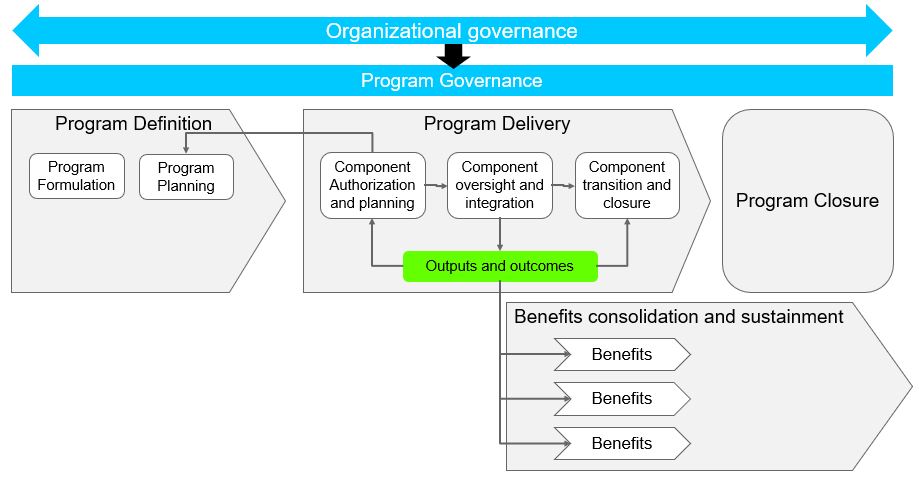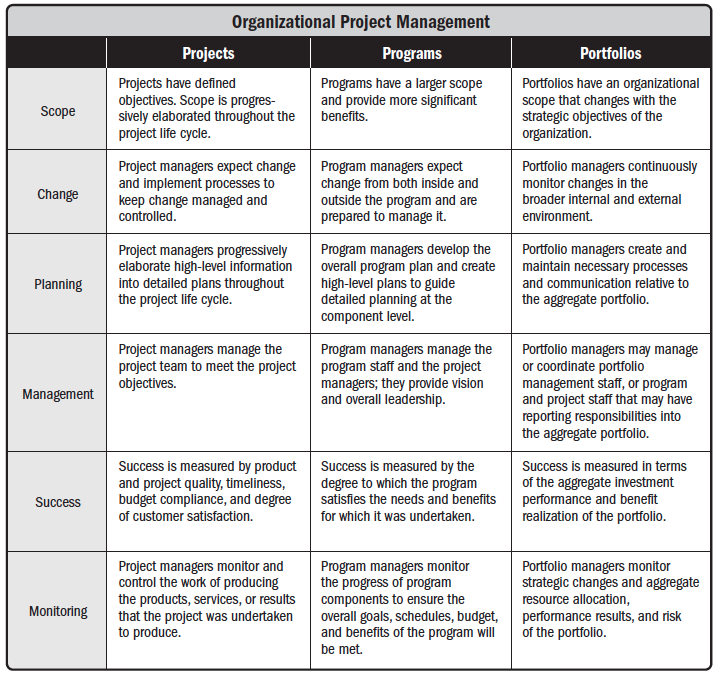The Standard for Program Management provides guidance on the principles of program management. I’m reading the fourth edition.
It provides generally accepted definitions of programs and program management and concepts important to their success—program management performance domains, the program life cycle, and important program management principles, practices, and activities.
Purpose of the standard for program management
- Principles of program management are tenets that are held to be true and important for the effective management of programs.
- Generally recognized means there is general consensus that the described principles, knowledge, and practices are valuable and useful.
- Good practice means there is general agreement that application of the principles, knowledge, and practices improves the management of programs.
The Standard for Program Management is also intended to provide a common understanding of the role of a program manager in general, and especially when interacting with:
- Portfolio managers whose portfolio(s) include the program or its components;
- Project managers whose projects are part of the program;
- Program sponsors and other members of the program steering committee.
- Program or project management office;
- Program team members working on the program or on other subsidiary programs;
- Program beneficiaries; and Other stakeholders or stakeholder groups.
What is a program
A program is defined as related projects, subsidiary programs, and program activities managed in a coordinated manner to obtain benefits not available from managing them individually.
Such benefits are delivered to the sponsoring organization as outcomes that provide utility to the organization and the program’s intended beneficiaries or stakeholders.
The following is a list of program elements and their definitions:
- Components are projects, subsidiary programs, or other related activities conducted to support a program.
- Projects are temporary endeavors undertaken to create a unique product, service, or result.
- Projects are used to generate the outputs or outcomes required by programs, within defined constraints, such as budget, time, specifications, scope, and quality.
- Subsidiary programs, sometimes referred to as subprograms, are programs sponsored and conducted to pursue a subset of goals important to the primary program.
- Portfolio is a collection of projects, programs, subsidiary portfolios, and operations managed as a group to achieve strategic objectives.
The primary value of managing an initiative as a program is based on the acknowledgement of the program manager’s readiness to adapt strategies to optimize the delivery of benefits to an organization.
 What is Program Management
What is Program Management
It is defined as the application of knowledge, skills, and principles to a program to achieve the program objectives and to obtain benefits and control not available by managing program components individually.
The Program Management Performance Domains are:
- Program Strategy Alignment,
- Program Benefits Management,
- Program Stakeholder Engagement,
- Program Governance,
- and Program Life Cycle Management.
Actions related to these inter-dependencies may include:
- Monitor benefits realization of program components to ensure they remain strategically aligned to the organization’s goals.
- Lead and coordinate program activities (for example, financing and procurement) across all program components, work, or phases.
- Communicate with and report to stakeholders to provide an integrated perspective on all activities being pursued within the program.
- Proactively assess and respond to risks spanning multiple components of the program.
- Align program efforts with the organizational strategy and the program’s business case.
- Resolve scope, cost, schedule, resource, quality, and risk issues within a shared governance structure.
Relationship between portfolio, program and project management
Portfolio, program, and project management all provide a structured means for organizations to align and effectively pursue organizational strategies.
However, portfolio, program, and project management differ in their focus and in the way they contribute to the achievement of strategic goals.
- Portfolio management is the centralized management of one or more portfolios to achieve strategic objectives.
- Portfolio management focuses on the establishment and use of good practices when choosing programs or projects to sponsor, prioritizing their goals and work, and ensuring that they can be adequately resourced.
- Program management is the application of knowledge, skills, and principles to a program to achieve the program objectives and to obtain benefits and control not available by managing program components individually.
- Project management is the application of knowledge, skills, tools, and techniques to project activities to meet the project requirements.
 The relationships are always collaborative.
The relationships are always collaborative.
The distinctions among portfolio, program, and project management can be made clear through their interactions:
- Portfolio managers ensure that programs and projects are selected, prioritized, and staffed according to an organization’s strategic plan for realizing desired organizational value.
- Project managers focus on the generation of the specific outputs and outcomes required by an organization, as part of a project, a program, or a portfolio.
Relationship among organizational strategy, program management, and operations management
Organizations employ program management to pursue complex initiatives that support organizational strategy.
Moreover, program managers often find that the benefits delivered by programs may influence an organization’s approach to or scope of operational activities, and that program deliverables are transferred to organizational entities to ensure that their delivery of benefits is sustained.
For these reasons, it is important that program managers establish collaborative, mutually supportive relationships with those responsible for managing operations within an organization.
Together, program and operational managers are responsible for ensuring the balanced and successful execution of an organization’s strategic objectives.
Business value
Organizations employ program management to improve their abilities to deliver benefits.
However, the effective use of portfolio, program, and project management enables organizations to employ reliable, established processes to generate new business value by enabling an organization to effectively pursue new business strategies consistent with its mission and vision for the future.
- Portfolio management ensures that an organization’s programs, projects, and operations are aligned with an organization’s strategy.
- Program management enables organizations to more effectively pursue their strategic goals through the coordinated pursuit of projects, subsidiary programs, and other program-related activities.
- Project management enables organizations to more efficiently and effectively generate outputs and outcomes required for the pursuit of an organization’s objectives by applying knowledge, processes, skills, tools, and techniques that enhance the delivery of outputs and outcomes by projects.
The role of the Program Manager
A program manager is the person authorized by the performing organization to lead the team or teams responsible for achieving program objectives and is responsible for the leadership, conduct, and performance of a program, and for building a program team that is capable of achieving program objectives and delivering anticipated program benefits.
In general, program managers are expected to:
- Work within the five Program Management Performance Domains.
- Interact with project and other program managers to provide support and guidance on individual initiatives.
- Interact with portfolio managers to ensure that programs are provided with the appropriate resources and priority.
- Collaborate with governance bodies, sponsors and the program management office to ensure the program’s continued alignment with organizational strategy and ongoing organizational support.
- Interact with operational managers and stakeholders to ensure that programs receive appropriate operational support and that benefits delivered by the program can be effectively sustained.
- Ensure that the importance of each of a program’s components is recognized and well understood.
Program manager competences
The expertise required of a program manager depends to a large degree on the proficiencies required to manage the complexity, ambiguity, uncertainty, and change associated with a program’s outcomes or environment.
The skills required may differ significantly among programs of different types, or even among programs of similar types facing dissimilar challenges.
The following skills and competences are commonly required by program managers:
- Communication skills.
- Stakeholder engagement skills.
- Change management skills.
- Leadership skills.
- Analytical skills.
- Integration skills.
Role of the program sponsor
A program sponsor is an individual or a group that provides resources and support for the program and is accountable for enabling success.
A program steering committee may assume the role of a program sponsor. However, the program sponsor is usually an individual executive who is committed to ensuring that the program is appropriately supported and able to deliver its intended benefits.
The program sponsor also provides valuable guidance and support to the program manager, ensuring that the program receives appropriate high-level attention and consideration, and that the program manager is informed of organizational changes that may affect the program.
Role of the Program Management Office
A program management office is a management structure that standardizes the program-related governance processes and facilitates the sharing of resources, methodologies, tools, and techniques.
A program management office may support the program manager with the management of multiple projects and program activities, for example, by:
- Defining standard program management processes and procedures;
- Providing training to ensure that standards and practices are well understood;
- Supporting program communications;
- Supporting program level change management activities;
- Conducting program performance analyses;
- Supporting management of the program schedule and budget;
- Defining general quality standards for the program and its components;
- Supporting effective resource management;
- Providing support for reporting to leadership and program steering committees;
- Supporting document and knowledge transfer; and
- Providing centralized support for managing changes and tracking risks, issues, and decisions.